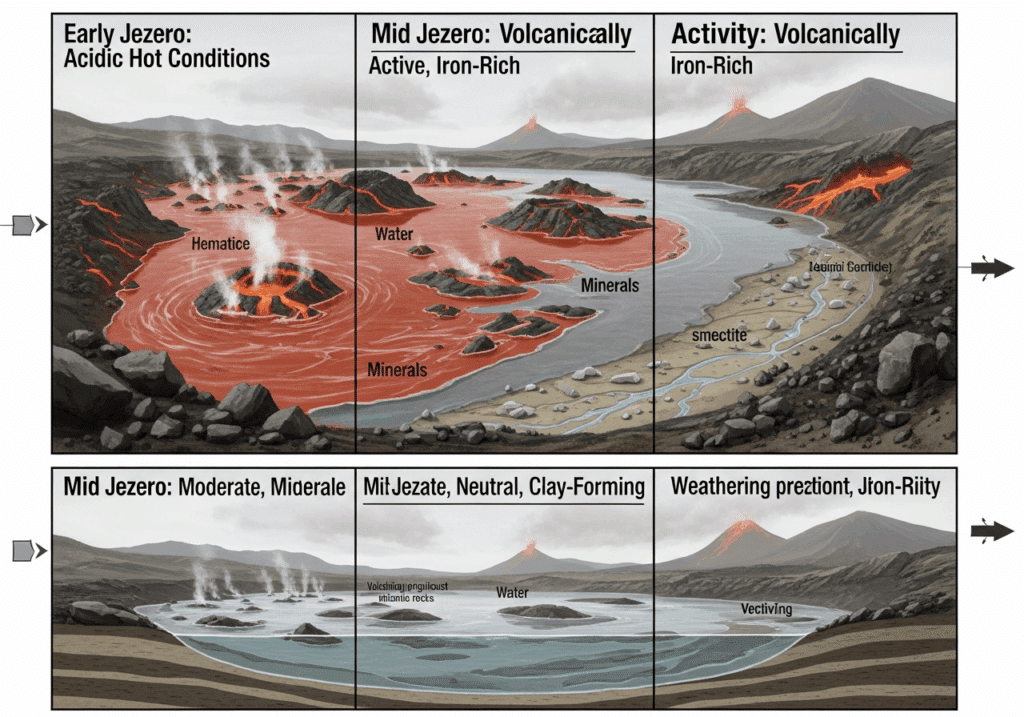NASA’s Perseverance Maps Multiple Ancient Water Systems on Mars
Sezarr Overseas News — November 2025
Jezero Crater wasn’t just wet once—it cycled through water again and again. New analyses from NASA’s Perseverance rover indicate that the landing site’s ancient delta recorded multiple episodes of flowing and standing water, preserved as stacked sedimentary layers and water-altered minerals. Together with subsurface radar data, the findings strengthen the case that parts of ancient Mars were sustainably habitable for extended periods of time.
Discovery Breakthrough: Evidence for Multiple Water Episodes

Field images and spectroscopy across Jezero’s delta show layered mudstones, sandstones, and mineral phases—including clays, sulfates, and carbonates—that typically form in persistent watery environments. Subsurface profiles from the rover’s RIMFAX (Radar Imager for Mars’ Subsurface Experiment) ground-penetrating radar reveal buried, laterally continuous reflectors consistent with repeated deposition and erosion cycles, the hallmark of changing river-lake conditions over geological time.
These observations align with research indicating Jezero experienced several distinct hydrologic phases, each potentially supporting life’s basic chemical requirements. A 2025 study used the Mineral Identification by Stoichiometry (MIST) approach to classify diverse minerals that chronicle Mars’ evolving water chemistry.
Also in science & policy: global platform policy shifts can quickly reshape research data access—an issue that increasingly touches planetary missions and public datasets.
Scientific Significance: Why Habitability Requires Time

Habitability isn’t merely about having water—it’s about maintaining it long enough for complex chemistry to develop. The stacked delta strata and aqueous minerals imply environmental stability and repeated wet-dry cycling, conditions that on Earth promote organic synthesis and preservation over geological timescales.
Fine-grained mudstones are particularly promising because they efficiently trap organic compounds and shield them from Mars’ harsh radiation environment. Jezero’s record now points to long-lived water systems, not brief episodic flooding, reshaping how scientists frame ancient Mars life hypotheses.
Methodology spotlight: advances in algorithmic analysis are transforming discovery pipelines—see our coverage of AI-accelerated discovery at scale.
Advanced Instrumentation: How Perseverance Makes Discoveries
PIXL provides elemental chemistry at grain scale; SHERLOC uses deep-UV Raman/fluorescence to map organics and hydrated minerals; SuperCam performs LIBS and imaging; and RIMFAX peers meters below the surface to trace hidden interfaces that outcrops alone can’t reveal.
Peer-reviewed RIMFAX results document subsurface layering, dielectric contrasts, and attenuation patterns consistent with fluvio-lacustrine deposits—key context for drilling target selection and geologic interpretation.
Big-science instruments increasingly depend on cutting-edge compute. Read how enterprise AI races are evolving in Microsoft’s superintelligence push and why hardware supply matters in chip export restrictions.
Astrobiology Implications: Multiple Chances for Ancient Life
The discovery of multiple hydrologic episodes widens both the temporal window and environmental diversity where microbes could have thrived—delta bottoms rich in organic sediments, fluctuating shorelines with varying chemistry, and shallow subsurface aquifers protected from radiation. On Earth, comparable deltaic mudstones and evaporite-rich sequences often preserve organics for immense spans of time.
Presence of organics—if confirmed in returned samples—will not alone prove biology. Definitive answers will rely on isotopes, molecular complexity, and spatial context from Earth-based labs.Read next on Sezarr Overseas:
- Snapchat + Perplexity: AI search meets social
- OpenAI–AWS deal and the future of cloud AI
- Are AI stocks a bubble?
Mission Progress: Sampling Strategy and Current Status
Sample Collection Achievement
As of July 24, 2025, Perseverance has utilized 33 of its 43 sample tubes, including 27 rock cores, 2 regolith samples, and 1 atmospheric sample. Ten backup samples were deposited at the “Three Forks” depot in 2023 to provide redundancy.
Technology Demonstrations and Exploration Milestones
By October 2024, the rover had driven over 30 km across Jezero’s varied terrain. The MMRTG power source and autonomous navigation enabled extensive exploration despite Mars’ harsh environment.
Ingenuity helicopter: 72 flights completed; mission concluded January 25, 2024, after rotor damage on the final flight.
Mars Sample Return: Realistic Timeline
After a 2024 program reset, NASA is revising architectures to control cost and risk. Current outlooks point to returns in the 2030s rather than early-2030s targets, pending funding and design decisions.
For how policy and markets shape big-science timelines, see our coverage of US tech policy shifts, market risk events, and semiconductor demand signals.
Future Exploration: Beyond Sample Collection
Immediate Science Priorities
Ongoing campaigns target the interface between clay-rich and sulfate-bearing units to maximize chances of preserved biosignatures.
Human Exploration Applications
Mapping ancient—and potentially ice-associated—water systems informs ISRU, landing-site safety, and future crewed operations.
Explore more deep-tech features: AI in health, chip thermals, and industry timelines.
FAQs
Did Perseverance discover flowing water today?
No—evidence points to ancient episodes billions of years ago; today’s surface is too cold and dry for stable liquid water. How many samples has Perseverance collected?
33 tubes used as of July 24, 2025 (27 rock cores, 2 regolith, 1 atmosphere, plus witness tubes). Is the Ingenuity helicopter still flying?
No. The mission ended January 25, 2024, after the 72nd flight. When will Mars samples reach Earth?
NASA’s revised planning suggests the 2030s, pending final architecture and funding.
Scientific Findings Disclaimer
This article reflects peer-reviewed studies and official NASA updates current as of November 11, 2025 (IST). Mission plans may evolve.